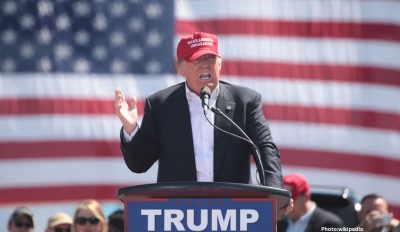The Indian rupee found itself as the second worst-performing currency in Asia on April 11, largely due to global turbulence resulting from the announcement of reciprocal tariffs by U.S. President Donald Trump on April 2. Despite a notable decline in the U.S. dollar index, the Indian currency failed to gain strength, weighed down by weak foreign investor flows and declining domestic equities, according to market analysts.
Bloomberg data revealed that the rupee had depreciated by 0.73 percent between April 1 and April 11. Only the Indonesian rupiah performed worse, sliding by 1.40 percent in the same period. While the rupee struggled among Asian currencies, it did manage to fare better than some global peers. The South African rand fell 4.31 percent, the Brazilian real dropped 3.45 percent, the Norwegian krone lost 1.60 percent, the Australian dollar slipped 0.92 percent, and the Mexican peso declined 0.85 percent against the U.S. dollar over the same timeframe.
Dilip Parmar, a senior research analyst at HDFC Securities, pointed out that although the rupee was relatively less volatile among Asian currencies, it still underperformed in April due to capital outflows and overall risk aversion in global markets. “The Indian rupee remained least volatile among the Asian peers but underperformed so far this month amid foreign fund outflows amid volatile risk assets. The upbeat economic data and RBI’s (Reserve Bank of India) interest rate cut fell short in attracting foreign institutions to invest in domestic equity amid global trade worries,” Parmar explained.
The pressure on the rupee was significantly tied to President Trump’s tariff announcement on April 2. During a White House event, Trump unveiled a global reciprocal tariff plan, using a chart to illustrate the new tax measures. The chart showed that the United States would impose a 34 percent tariff on goods from China, 20 percent on the European Union, 25 percent on South Korea, 26 percent on India, 24 percent on Japan, and 32 percent on Taiwan.
In contrast, the chart presented by Trump suggested that India was already levying a 52 percent tariff on U.S. imports. These charges were said to include issues such as “currency manipulation and trade barriers.” In response, the U.S. would impose “discounted reciprocal tariffs” of 26 percent on imports from India.
The market reaction was swift and negative. Stock markets around the globe suffered steep losses following the announcement, with foreign investors pulling significant funds out of Indian equities. This capital flight exerted downward pressure on the rupee. However, the concurrent decline in the dollar index helped limit the rupee’s depreciation to some extent. The index, which gauges the dollar’s strength against a basket of six major currencies, dropped to 99.460—its lowest level since July 18, 2023, when it had reached 99.941.
Adding another twist to the story, Trump declared a 90-day pause on April 10 for the reciprocal tariffs, sparing all countries except China from the full brunt of the levy for the time being. As part of this new adjustment, a baseline 10 percent tariff was retained for all nations except China, which saw its rate soar to 125 percent. This partial rollback came amid mounting political and economic pressure from within the United States.
Over the past few days, Trump had come under fire from fellow Republicans and business leaders who voiced concerns about the consequences of his tariff policy. With markets experiencing sharp selloffs, the fear of igniting a global trade war loomed large. Investors and economists warned that these measures might tip the world economy into a recession. The panic in financial markets forced Trump to reconsider his aggressive tariff strategy.
“People are getting a little bit afraid,” Trump acknowledged when speaking about the broader response to his policy. He added, “I thought that people were jumping a little bit out of line. They were getting yippy.”
A major factor behind Trump’s partial reversal was the dramatic selloff in the U.S. government bond market. According to reports, this development had raised alarms within the administration. U.S. Treasury Secretary Scott Bessent and other White House officials expressed concerns over the implications for the broader financial system.
Despite the tariff pause, uncertainty remains high in global markets. Investors remain cautious, closely monitoring future decisions from the U.S. administration and their ripple effects on emerging markets, including India. The rupee, caught in this maelstrom of global financial anxiety, is unlikely to see immediate relief unless foreign investment flows resume and geopolitical tensions ease.
The volatility highlights the precarious position of emerging market currencies, which are increasingly sensitive to global trade developments. While India’s economic fundamentals remain relatively strong, factors beyond its control—such as U.S. trade policy and global risk sentiment—continue to dictate the rupee’s direction in the near term.
Although the Reserve Bank of India had recently cut interest rates and released positive economic data, these moves were not enough to entice foreign institutional investors to return. With sentiment soured by the possibility of further escalation in trade tensions, the Indian rupee faces an uphill battle.
Ultimately, the rupee’s performance in the coming weeks will hinge on a delicate balance of global risk appetite, foreign capital inflows, and any additional policy signals from both the Reserve Bank of India and the U.S. Federal Reserve. For now, its status as one of the weakest Asian currencies underlines the interconnectedness of national economies and the disproportionate impact of global political decisions on domestic financial markets.
As long as reciprocal tariffs remain a credible threat and foreign investors remain wary, the rupee may continue to struggle to regain its footing despite relatively stable domestic economic indicators.


